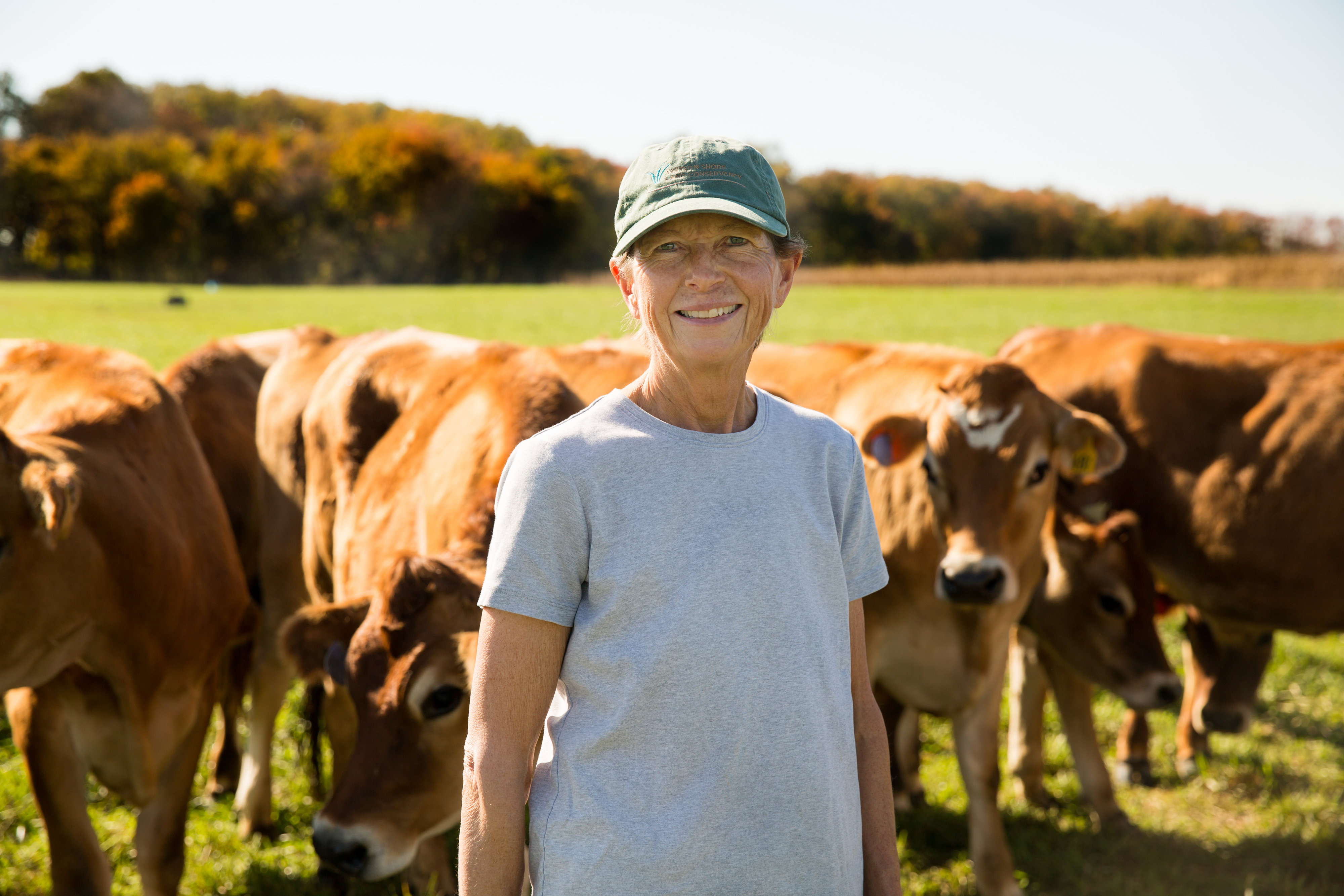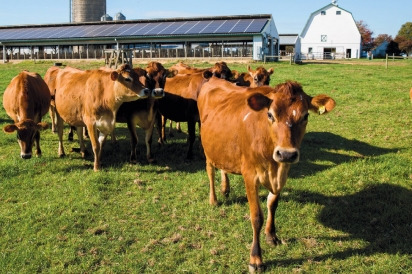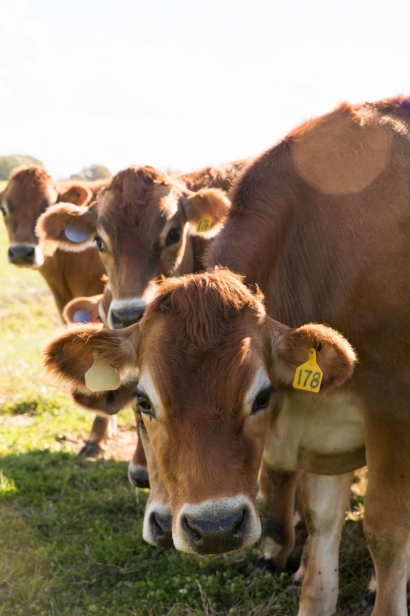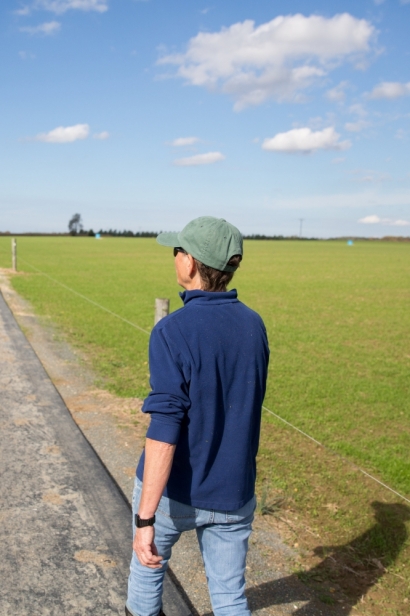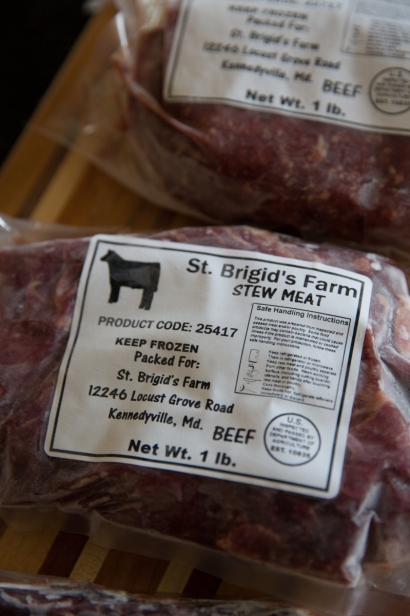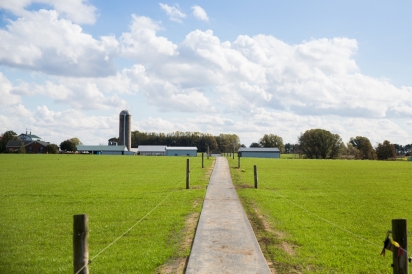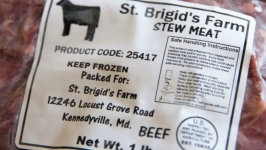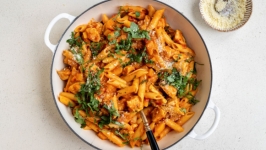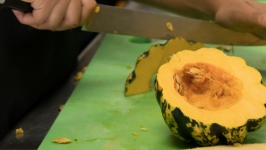St. Brigid's Farm: Raising Steaks and Standards on Maryland's Eastern Shore
How does a happy hamburger taste? Or a joyful glass of milk? In the heart of Kent County’s northern countryside, a jewelbox of a farm lets Eastern Shore consumers experience the difference for themselves. St. Brigid’s Farm, just a few miles outside Kennedyville, Maryland, hosts a herd of approximately 200 assiduously-cared-for Jersey cows, heifers, steers and calves on 62 acres of pasture. In return, these grass-fed cows produce milk, beef, and veal for markets both intensely local and broadly national. Cows, like people, are what they eat—and everything St. Brigid’s yields has the unmistakable essence of Kent County’s fresh air, sunshine and verdant meadows.
That kind of hyperbole is probably the last thing you would hear co-owner Judy Gifford say. Petite, intense, and no-nonsense, she works tirelessly in her role as St. Brigid’s full-time dairy farmer—a role that’s a culmination of a lifetime spent in animal husbandry and jobs in the dairy industry. When Gifford and her partner, bovine veterinarian Robert Fry, established St. Brigid’s Farm in 1996, it represented a life’s dream for each of them. Academically and professionally, Gifford had pursued a passion for dairy farming throughout her life, working for 4H, the National Institutes of Health and finally as a lobbyist for the National Milk Producers Federation. When the couple found a small Kent County farm for sale, they decided to start their own operation—a farm where they could apply their talents and deep expertise to a herd of their own. They named it St. Brigid’s Farm after the patron saint of dairymaids and scholars—representing Gifford as the former and Fry as the latter—and set to work with a herd of 69 Jersey heifers.
Over 20 years later, Gifford and Fry’s hard work and deeply considered choices have made St. Brigid’s a producer of stellar milk, beef, and veal. In an era when small family farms are disappearing, the Gifford- Fry farm is thriving thanks to their innovative application of best practices from both the organic and traditional farming worlds. From the type of cow St. Brigid’s raises, to how and where they farm, Gifford and Fry are doing something different—something special.
A drive out to St. Brigid’s is the best way to see what’s unique about the place—and to get your hands on a few tender Delmonicos or rib eyes. As you approach the property, the acres of soybeans or corn of neighboring farms give way to rolling, fenced pastures—planted in rye grass and clover as grazing fodder for the herd.
These fields are at the heart of St. Brigid’s core philosophy. After years of working in traditional dairy operations, Fry became a convert to the health benefits of MIG—managed intensive grazing—for its benefits to consumer and cow. Grass fed beef is higher in carotene, vitamin E and omega-3 fatty acids and lower in saturated fats. It’s also 2-3 times higher in CLA, Conjugated Linoleic Acid, a powerful anti-carcinogen. Grazing is also good for the health of the herd. “I liked the idea of cows roaming, out of confinement,” Gifford reflects. “And as a veterinarian, Bob saw the health benefits of pasture. It’s so much better for their legs and feet, and just the whole herd behavior. They get to go outside and run around, get some sunshine. Get rained on. That’s what cows should do.”
Planting pasture, therefore, was one of the first major changes Fry and Gifford made at St. Brigid’s. “It used to be wheat, corn, the whole routine beforehand,” Gifford recalls. “It’s only 60 acres, so that kind of farming wouldn’t even pay the mortgage. We put the cows out on the pasture and luckily we got a bit of rain that summer and our pastures grew. Now, 20 years later, we’ve just reseeded them and hopefully we’ll get a good stand.”
The herd’s diet and lack of confinement clearly has benefits for the cows as well as the consumer. The diminutive Jersey heifers radiate health and well-being. Each one has its own name, too—an endearing habit of Gifford’s that reflects both the farm’s small herd size and her genuine fondness for the little cows. Jerseys are an unusual breed for a dairy farm—the eponymous black and white Holsteins are much more common—but it’s one for which Gifford has long had a soft spot since her days on a family farm in Connecticut.
“I bought my first Jersey when I was twelve, with my own money,” she says. “Every year I would buy a couple more, to show and sell, up until college. In the 60’s and the 70’s, everybody had these really expensive Holsteins that they were showing. I couldn’t compete with the show people with the Holstein cows, but I could compete with the Jerseys—and I liked them better anyhow. They have great personalities.”
The dusky Jerseys are an important element in the guiding principles behind St. Brigid’s Farm: to be economically viable, ecologically sound and socially just. “The Jerseys are efficient converters of turning feed into milk, and smaller in footprint, which are the economic and the ecological components,” Gifford explains. “This isn’t a boutique hobby farm—we had to make money. And for the ecological element, pasture tied into that a lot. It’s the best practice you can do for soil health. It took us a while to get 100% of the farm into permanent pasture, but we’ve succeeded in that.”
Gifford and Fry are deliberate in their decisions about maintaining that pasture, with an environmentalist’s eye towards considerations about runoff and sediment. “We do minimal tillage, use buffer strips, and have a nutrient management plan,” Gifford says. “We fence the cows out of waterways, and have since before it was a requirement.” Perhaps their loftiest goal, to be socially just, is achieved by paying workers a living wage, being active in the community, and donating volunteer time and money to local non-profits, from a food bank to a produce CSA. For a small 60-acre farm, St. Brigid’s is undoubtedly hitting their marks—and we haven’t even gotten to their production yet.
Although organic beef and milk has become the standard for discerning consumers, Gifford is quick to correct the assumption that because they’re small and thoughtful, St. Brigid’s must naturally be organic. It’s too restrictive—so Gifford and Fry combine the strengths of the organic system with elements from more conventional farming. “With organic farming, there’s a list of things you can and cannot do. I didn’t get into farming to have some committee in DC write a set of rules that limit my flexibility and my innovation,” Gifford states adamantly. “We think there’s benefit in both systems—organic and conventional—and by following our own way, we farm our land and treat our animals the best we can.”
The care Gifford and Fry pride themselves on shines through in their products. St. Brigid’s grass-fed cows each produce about 2,250 gallons of milk per year, exceptionally rich in butterfat and milk protein. Sold through a cooperative with Land O’ Lakes, their milk is sold nationally as butter and cheese. But locals have access to the really good stuff—St. Brigid’s beef and meadow veal. Their beef is grass fed and finished, with no hormones, no antibiotics, and no radiation. Once sent off for processing, Fry and Gifford’s attention to detail continues—all of their beef is dry-aged for 18-21 days, for example, in order to achieve an unparalleled tenderness and an intense flavor profile. Their veal, which enjoy the same access to spring grass and fresh air as the rest of the herd, are fed a diet of whole milk for their 5-month life span and are raised with the kind of affection most of us reserve for our pets.
Whether beef or veal, St. Brigid’s is the source of some excellent meats, and they have a loyal following on the Upper Eastern Shore. Subscribers to their “Medley of Meats” service get to choose their own selection of beef roasts, steaks, ground beef, or bones, and veal chops, cutlets, and sweetbreads, which are then dropped off weekly at locations in Chestertown or in Middletown/Odessa Township. For those folks who want the chance to buy something special (or something last-minute), drop by the farm and marvel over a selection that would make any carnivore cry with gratitude. And there’s always the option to take advantage of the relationship St. Brigid’s has developed with several regional restaurants—Russet in Philadelphia, Luisa’s in Chestertown, and K&B Market in Kennedyville—where chefs artfully prepare dishes that highlight the farm’s beef and veal. No matter what your culinary speed, there’s no excuse not to find the meaty marvel of St. Brigid’s steak on the end of your fork.
It’s a rarity these days to feel good about the ways your food is produced. Too often, learning more about the process from field to table can reveal some unsavory practices associated with the things we choose to eat. St. Brigid’s cheerfully refutes that idea. From their meticulously tidy barns to the way the tawny little calves stagger forward to have strangers scratch around their ears, Gifford and Fry have created a little farming Eden that’s the result of professional savvy, loving care and high standards. Consumers can genuinely feel good about enjoying St. Brigid’s beef, knowing that they are paying for the best, most scrupulously produced product money can buy. These are happy cows and steers, you see, cared for by happy farmers. And Gifford doesn’t see an end in sight. “I love my cows, I love being outside, I like the birds, I like to walk out to the fields, I like my dogs and working with them every day, I like having calves born. When you do your job well, and you love what you do, well, what’s better than that?”
Learn more at www.stbrigidsfarm.com


